|
|
 |
 |
| Texas Hold ’em Strategy Guide |
| |
|
Texas Hold
‘em is one of the most popular forms of poker, least of all because of the
amount of strategy involved. As Kenny Rogers once famously sang,
“You’ve got to know when to hold ‘em, and know when to fold
‘em...”. But how do you know which hands to hold and which to fold,
and what strategies can you apply to give yourself a better idea of the true
strength of your hand?
What are you holding or
folding?
The holding and folding referred to above mean your hole
cards. These are the two cards that are dealt face down to you at the start of
a game of Texas Hold ‘em. You are the only one who can see these cards,
and you can use either or both in combination with the five cards dealt face up
on the table, which everyone can see and use. |
| |
 |
| Source: Wikimedia |
| |
The problem is the
cards dealt face up are only revealed in stages: the first three (known as the
flop), the fourth card (known as the turn) and finally, the fifth card (known
as the river). You need to decide whether to hold or fold each time and to make
matters worse, you need to make your first decision before you see any of these
cards, which means you need to be able to assess the value of your pair of hole
cards fast and accurately.
Hole card
combinations
There are 1,326 possible combinations of two cards
from a standard 52-card deck, which comes down to
169 possible combinations when you take out pairs of equal
value. Your chances of these being worth anything on their own are slim as just
1 in 17 for a pair and 4 in 17 get a matching suit.
Rating your hole cards
When 12 out of 17 sets of hole
cards have no immediate value, how do know which of these to hold onto? The key
to success is in rating your hole cards accurately. You need to know how to
calculate the potential of your hole cards, even when they initially appear to
have none. What’s more, you need to be able to do this in just a minute or
two, as you need to make your call before the flop is dealt.
Systems and strategies
Just like the many statistics
and strategies for the game of
roulette, many leading players and mathematicians have created systems for
grading Texas Hold 'em poker hands. Both 14x World Series of Poker Champion
Phil Hellmuth and the top player and strategist David Sklansky have proposed
tier ranking systems for hole cards.
Hellmuth’s system has six
tiers:
- 1. AA, KK, AKs, QQ, AK
- 2. JJ, TT, 99
- 3. 88, 77, AQs, AQ
- 4. 66, 55, 44, 33, 22, AJs, ATs, A9s,
A8s
- 5. A7s, A6s, A5s, A4s, A3s, A2s, KQs, KQ
- 6. QJs, JTs, T9s, 98s, 87s, 76s, 65s
Any pair of hole cards
not achieving a ranking should be folded. The Sklansky system is built on
similar principles but has eight different tiers as shown below: |
| |
 |
| Source: Wikimedia |
| |
These systems are
hard to learn, but once you have mastered them, you will have a good idea as to
your chances of winning with any given pair of cards.
The Chen formula
If you don’t fancy learning a
complicated table of hand rankings, you could try the Chen formula, proposed by
Bill Chen who used his Ph.D. in math to analyze
the mathematics of poker.
Under the Chen system, you
can quickly calculate the relative value of your hand as follows:
- Assign a value to your top card A=10, K=8,
Q=7, J=6 with all others valued at half their numerical value (e.g. 8=4
pts)
- Double your points for a pair (e.g.
KK=16)
- Add 1 point if your cards are consecutive and
2points if they match suit
- Lose points for gaps between your cards with
-1 for a one-card gap, -2 for a two-card gap, -4 for a three-card gap and -5
for a larger card gap
- Add a point for a single-card gap if the top
card is lower than a queen (as the run can go both ways)
Thus, the maximum value
will be 20 points — for an AA — down to minus one and a half points
for a completely unrelated low-rank hand such as a 7 of clubs and 2 of diamonds
(7x ½ =3½ -5 for the gap= -1½).
The Chen formula
can be quite hard to master, but at least once you have learned it, you will
not risk mixing up the cards in the different tiers as you could with other
systems. |
| |
 |
| Source: Wikimedia |
| |
Keeping your cool
Constantly looking at your hole cards
can make you look unsure or nervous, so it is also worthwhile to learn a system
for remembering what you have. Try to come up with your own mnemonic to
remember mixed suits such as points for diamonds and spades and rounds for
clubs and hearts. Or use the initials to create memorable word
combinations. |
| |
| |
 |
|
| |
|
|
 |
|
 |